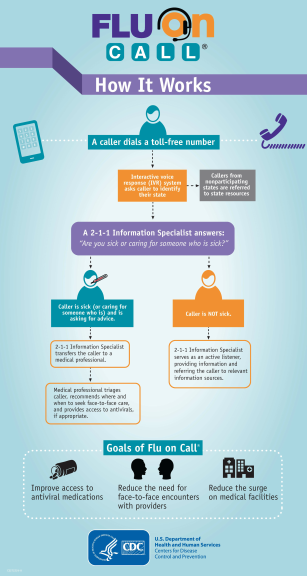Next year, 2018, will mark the 100th anniversary of the 1918 Influenza Pandemic (the so-called “Spanish Flu”), estimated to have killed 3% to 6% of the world’s population. Since it is nearly impossible to predict when the next pandemic will occur, the Centers for Disease Control and Prevention (CDC) is conducting ongoing efforts to bolster the nation’s flu response capacity. Flu on Call® is a new pandemic preparedness capability and a critical part of CDC efforts to prepare for the next flu epidemic whenever it may strike.
An ongoing effort led by the Centers for Disease Control and Prevention (CDC), in collaboration with United Way Worldwide (UWW), NACCHO, ASTHO and other partners, Flu on Call® is designed to establish a national network of telephone help lines designed for use during a severe influenza pandemic.
The goals of Flu on Call® are to:
- Improve access to antiviral medications for sick people during a pandemic.
- Direct sick people to the level of care they need.
- Reduce the surge on medical facilities.
The Flu on Call® hotlines are staffed by information specialists and medical professionals. People who contact Flu on Call® because they’re sick (or caring for someone who is), will be able to talk to a medical professional to get medical advice and to be matched to the appropriate level of care. If the symptoms of the ill person meet the guidelines of the protocol, medical professionals may be able to provide access to antiviral medications over the phone.
Flu on Call® is modeled on successful statewide projects that were implemented during the 2009 H1N1 pandemic. For example, during the 2009-2010 H1N1 pandemic influenza response, the Minnesota Department of Health established the statewide Minnesota FluLine (MN FluLine). The MN FluLine fielded more than 27,000 calls between Oct. 2009, and March 2010 and reported high levels of caller satisfaction and no untoward events. This system reached many rural and uninsured Minnesotans, and may have reduced surge on medical facilities by averting nearly 11,000 in-person health-care encounters.
From 2013-2017, CDC, in collaboration with its partners, conducted seven exercises of the Flu on Call® system, making more than 3,000 simulated calls to test system functionality. In addition to these exercises, CDC, United Way Worldwide, two United Way 2-1-1 centers, and two local health departments, conducted the Flu on Call® Demonstration Project in 2016. The Demonstration project took place in Milwaukee County, Wisconsin, and in Dodge, Saunders, and Washington counties in rural Nebraska. This Demonstration was successful and indicated the feasibility of activating and operating Flu on Call® during an emergency.
Flu on Call® is not meant to serve as a replacement for medical clinics or practices and the relationships that providers have with their patients. The system would only be activated during a pandemic when the demand for care has impacted the medical system’s ability to provide it.
For more information, please visit:
- NACCHO Toolbox: The Flu on Call® Toolkit
- NACCHO Flyer: Flu on Call® FAQs
- Biosecurity and Bioterrorism Journal Article: Broadening Access to Medical Care during a Severe Influenza Pandemic: The CDC Nurse Triage Line Project
- Biosecurity and Bioterrorism Journal Article: Facilitating Access to Antiviral Medications and Information during an Influenza Pandemic: Engaging with the Public on Possible New Strategies
- Public Health Rep. Journal Article: Design and Implementation of a Statewide Influenza Nurse Triage Line in Response to Pandemic H1N1 Influenza









